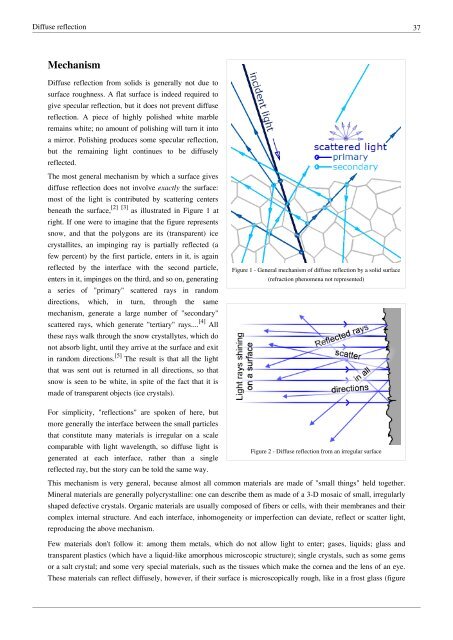3D graphics eBook - Course Materials Repository
3D graphics eBook - Course Materials Repository
3D graphics eBook - Course Materials Repository
Create successful ePaper yourself
Turn your PDF publications into a flip-book with our unique Google optimized e-Paper software.
Diffuse reflection 37<br />
Mechanism<br />
Diffuse reflection from solids is generally not due to<br />
surface roughness. A flat surface is indeed required to<br />
give specular reflection, but it does not prevent diffuse<br />
reflection. A piece of highly polished white marble<br />
remains white; no amount of polishing will turn it into<br />
a mirror. Polishing produces some specular reflection,<br />
but the remaining light continues to be diffusely<br />
reflected.<br />
The most general mechanism by which a surface gives<br />
diffuse reflection does not involve exactly the surface:<br />
most of the light is contributed by scattering centers<br />
beneath the surface, [2] [3] as illustrated in Figure 1 at<br />
right. If one were to imagine that the figure represents<br />
snow, and that the polygons are its (transparent) ice<br />
crystallites, an impinging ray is partially reflected (a<br />
few percent) by the first particle, enters in it, is again<br />
reflected by the interface with the second particle,<br />
enters in it, impinges on the third, and so on, generating<br />
a series of "primary" scattered rays in random<br />
directions, which, in turn, through the same<br />
mechanism, generate a large number of "secondary"<br />
scattered rays, which generate "tertiary" rays.... [4] All<br />
these rays walk through the snow crystallytes, which do<br />
not absorb light, until they arrive at the surface and exit<br />
in random directions. [5] The result is that all the light<br />
that was sent out is returned in all directions, so that<br />
snow is seen to be white, in spite of the fact that it is<br />
made of transparent objects (ice crystals).<br />
For simplicity, "reflections" are spoken of here, but<br />
more generally the interface between the small particles<br />
that constitute many materials is irregular on a scale<br />
comparable with light wavelength, so diffuse light is<br />
generated at each interface, rather than a single<br />
reflected ray, but the story can be told the same way.<br />
Figure 1 - General mechanism of diffuse reflection by a solid surface<br />
(refraction phenomena not represented)<br />
Figure 2 - Diffuse reflection from an irregular surface<br />
This mechanism is very general, because almost all common materials are made of "small things" held together.<br />
Mineral materials are generally polycrystalline: one can describe them as made of a 3-D mosaic of small, irregularly<br />
shaped defective crystals. Organic materials are usually composed of fibers or cells, with their membranes and their<br />
complex internal structure. And each interface, inhomogeneity or imperfection can deviate, reflect or scatter light,<br />
reproducing the above mechanism.<br />
Few materials don't follow it: among them metals, which do not allow light to enter; gases, liquids; glass and<br />
transparent plastics (which have a liquid-like amorphous microscopic structure); single crystals, such as some gems<br />
or a salt crystal; and some very special materials, such as the tissues which make the cornea and the lens of an eye.<br />
These materials can reflect diffusely, however, if their surface is microscopically rough, like in a frost glass (figure
















